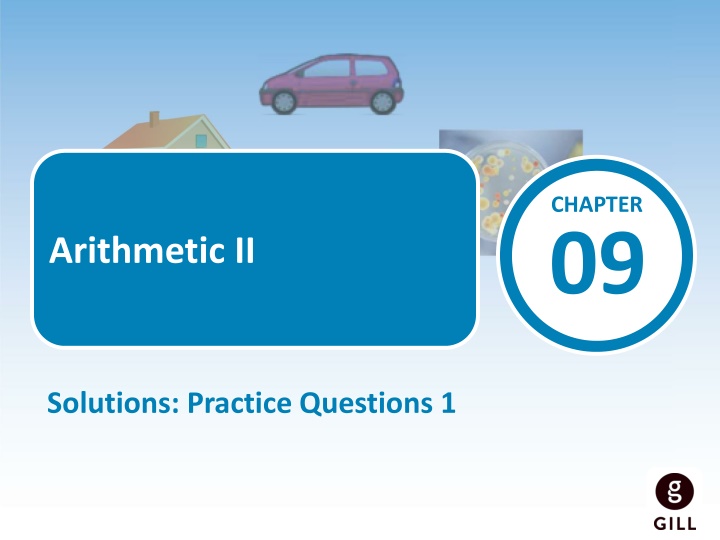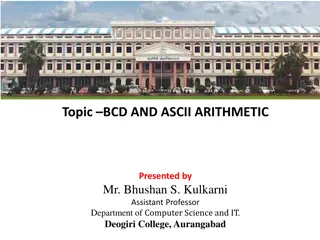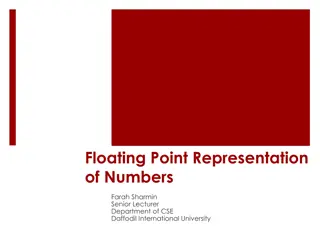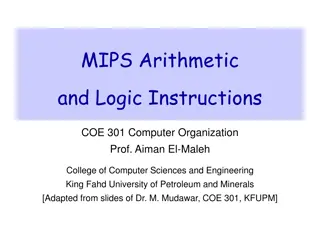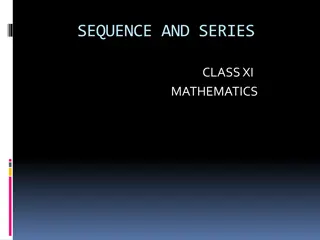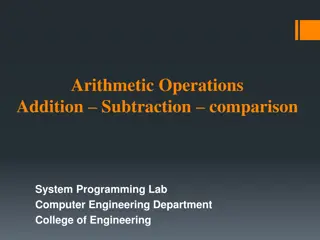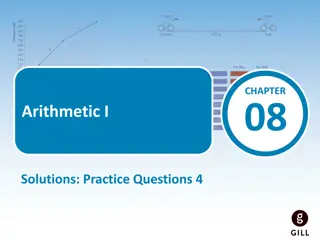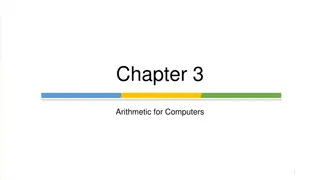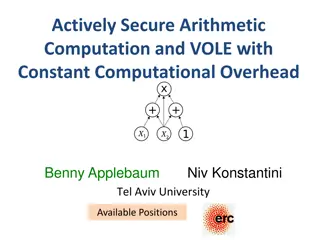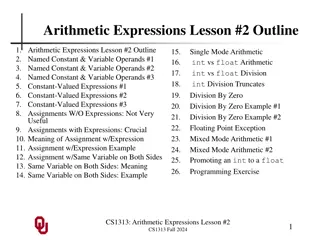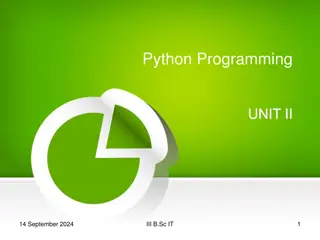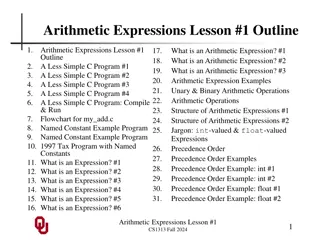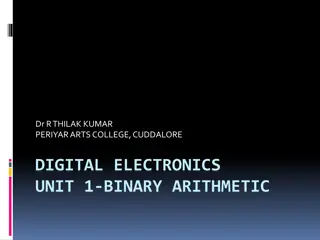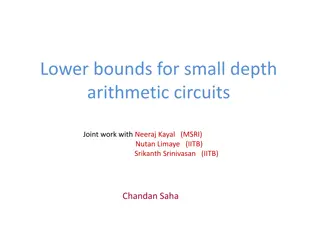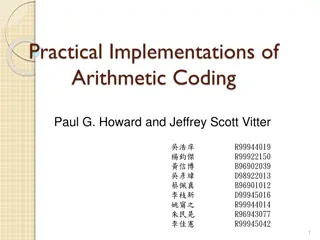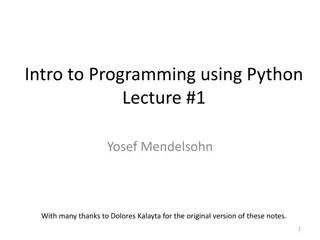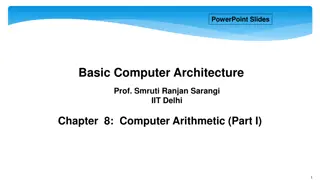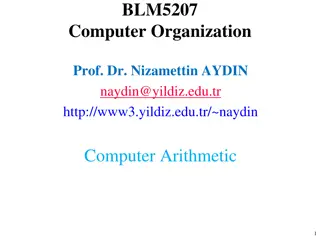Arithmetic II Practice Questions Solutions
In this set of practice questions, various scenarios involving income tax calculations are discussed and solved step-by-step. The examples cover different income levels, tax rates, tax credits, and standard rate cut-off points. From calculating gross tax to determining the tax paid and net income after deductions, these solutions offer a detailed insight into arithmetic in the context of income taxation.
Download Presentation

Please find below an Image/Link to download the presentation.
The content on the website is provided AS IS for your information and personal use only. It may not be sold, licensed, or shared on other websites without obtaining consent from the author.If you encounter any issues during the download, it is possible that the publisher has removed the file from their server.
You are allowed to download the files provided on this website for personal or commercial use, subject to the condition that they are used lawfully. All files are the property of their respective owners.
The content on the website is provided AS IS for your information and personal use only. It may not be sold, licensed, or shared on other websites without obtaining consent from the author.
E N D
Presentation Transcript
CHAPTER 09 Arithmetic II Solutions: Practice Questions 1
09 Practice Questions 1 1. Sam has a gross yearly income of 20,700. He has a standard rate cut-off point of 22,500 and a tax credit of 2,200. The standard rate of tax is 18%. Calculate: The amount of gross tax for the year. (i) All of Sam s income is under the standard rate cut-off point, so all tax is charged at 18%: Gross tax = 18% of 20700 = 0 18 20700 = 3726
09 Practice Questions 1 1. Sam has a gross yearly income of 20,700. He has a standard rate cut-off point of 22,500 and a tax credit of 2,200. The standard rate of tax is 18%. Calculate: The amount of tax paid for the year. (ii) Tax paid = Gross tax Tax credit = 3726 2200 = 1526
09 Practice Questions 1 2. Tanya has a gross yearly income of 41,500. She has a standard rate cut-off point of 22,750 and a tax credit of 3,950. The standard rate of tax is 20% of income up to the standard rate cut-off point and 41% on all income above the standard rate cut-off point. Calculate: The amount of gross tax for the year. (i) 41500 22750 = 18750 above standard rate Gross tax = 20% of 22750 + 41% of 18750 = 0 2 22750 + 0 41 18750 = 4550 + 7687 50 = 12237 50
09 Practice Questions 1 2. Tanya has a gross yearly income of 41,500. She has a standard rate cut-off point of 22,750 and a tax credit of 3,950. The standard rate of tax is 20% of income up to the standard rate cut-off point and 41% on all income above the standard rate cut-off point. Calculate: The amount of tax paid for the year. (ii) Tax paid = Gross tax Tax credit = 12237 50 3950 = 8287 50
09 Practice Questions 1 3. 1750 1295 = 455 above standard rate John has a gross income per fortnight of 1,750. Gross tax = 20% of 1295 + 42% of 455 The standard rate of income tax is 20% and the higher rate is 42%. = 0 2 1295 + 0 42 455 = 259 + 191 10 He has tax credits of 105 per fortnight and his standard rate cut- off point is 1,295 per fortnight. = 450 10 Tax paid = Gross tax Tax credit After tax is paid, what is John s net income per fortnight? = 450 10 105 = 345 10 Net pay = Gross pay Tax paid = 1750 345 10 = 1404 90
09 Practice Questions 1 4. Asal pays income tax, a universal social charge (USC) and pay-related social insurance (PRSI) on her gross wages. Her gross weekly wages are 625. Asal pays income tax at a rate of 21%. She has weekly tax credits of 72. How much income tax does she pay? (i) Gross tax = 21% of 625 = 0 21 625 = 131 25 Tax paid = Gross tax Tax credit = 131 25 72 = 59 25
09 Practice Questions 1 4. Asal pays income tax, a universal social charge (USC) and pay-related social insurance (PRSI) on her gross wages. Her gross weekly wages are 625. Asal pays USC at the rate of 1 6 % on the first 195, 3% on the next 112 and 5% on the balance. Calculate the amount of USC Asal pays. (ii) 1 6% of 195 = 0 016 195 = 3 12 3% of 112 = 0 03 112 = 3 36 5% of 318 = 0 05 318 = 15 90 ( 625 195 112 = 318) 22 38
09 Practice Questions 1 4. Asal pays income tax, a universal social charge (USC) and pay-related social insurance (PRSI) on her gross wages. Her gross weekly wages are 625. (iii) Asal also pays PRSI. Her total weekly deductions of income tax, USC and PRSI amount to 136 63 How much PRSI does Asal pay? Total deductions = Income tax + USC + PRSI 136 63 = 59 25 + 22 38 + PRSI 136 63 = 81 63 + PRSI 55 = PRSI
09 Practice Questions 1 4. Asal pays income tax, a universal social charge (USC) and pay-related social insurance (PRSI) on her gross wages. Her gross weekly wages are 625. (iv) Hence, find the rate of PRSI, which Asal pays on her gross earnings. Gross income = 625, PRSI = 55 55 625 8 8% = 100
09 Practice Questions 1 5. Howard has a gross weekly income of 925. He has a standard rate cut-off point of 588 and a tax credit of 75. The standard rate of tax is 17% of income up to the standard rate cut-off point and 39% on all income above the standard rate cut-off point. Calculate the amount of gross tax for the year. (i) Income above standard rate cut-off point = 925 588 = 337 Gross tax = 17% of 588 + 39% of 337 = 0 17 588 + 0 39 337 = 99 96 + 131 43 = 231 39
09 Practice Questions 1 5. Howard has a gross weekly income of 925. He has a standard rate cut-off point of 588 and a tax credit of 75. The standard rate of tax is 17% of income up to the standard rate cut-off point and 39% on all income above the standard rate cut-off point. Howard pays a Universal Social Charge (USC) of 1% on the first 300, then 3% on the next 140 and 6% on all remaining income. Calculate how much USC he owes. (ii) 1% of 300 = 0 01 300 = 3 00 3% of 140 = 0 03 140 = 4 20 6% of 485 = 0 06 485 = 29 10 ( 925 300 140 = 485) 36 30
09 Practice Questions 1 5. Howard has a gross weekly income of 925. He has a standard rate cut-off point of 588 and a tax credit of 75. The standard rate of tax is 17% of income up to the standard rate cut-off point and 39% on all income above the standard rate cut-off point. (iii) Calculate Howard s net salary after tax and USC have been deducted. Tax paid = Gross tax Tax credit = 231 39 75 = 156 39 Net salary = Gross salary Tax paid USC = 925 156 39 36 30 = 732 31
09 Practice Questions 1 6. Valerio has a gross yearly income of 73,150. He has a standard rate cut-off point of 32,500 and a tax credit of 4,850. The standard rate of tax is 21% of income up to the standard rate cut-off point and 42% on all income above the standard rate cut-off point. Calculate the amount of gross tax for the year. (i) Income above standard rate cut-off point = 73150 32500 = 40650 Gross tax = 21% of 32500 + 42% of 40650 = 0 21 32500 + 0 42 40650 = 6825 + 17073 = 23898
09 Practice Questions 1 6. Valerio has a gross yearly income of 73,150. He has a standard rate cut-off point of 32,500 and a tax credit of 4,850. The standard rate of tax is 21% of income up to the standard rate cut-off point and 42% on all income above the standard rate cut-off point. Valerio pays Universal Social Charge (USC) of 1% on the first 12,300, then 3% on the next 8,400 and 6% on all remaining income. Calculate how much USC he owes. (ii) 1% of 12300 = 0 01 12300 = 123 3% of 8400 = 0 03 8400 = 252 6% of 52450 = 0 06 52450 = 3147 ( 73150 12300 8400 = 52450) 3522
09 Practice Questions 1 6. Valerio has a gross yearly income of 73,150. He has a standard rate cut-off point of 32,500 and a tax credit of 4,850. The standard rate of tax is 21% of income up to the standard rate cut-off point and 42% on all income above the standard rate cut-off point. (iii) Calculate Valerio s net salary after tax and USC have been deducted. Tax paid = Gross tax Tax credit = 23898 4850 = 19048 Net salary = Gross salary Tax paid USC = 73150 19048 3522 = 50580
09 Practice Questions 1 7. Gustav earned 51,000 last year. The standard rate cut-off point was 29,200. The standard rate of income tax was 18% and the higher rate was 43%. Gustav has tax credits of 4,300. Calculate the tax paid by Gustav on his income. (i) Gross tax = 18% of 29200 + 43% of 21800 = 0 18 29200 + 0 43 21800 = 5256 + 9374 = 14630 Tax paid = Gross tax Tax credit = 14630 4300 = 10330
09 Practice Questions 1 Income levy = 2% of 51,000 7. Gustav also has to pay = 0 02 51000 a 2% income levy on his gross income = 1020 USC: USC of 2 5% on the first 10,000 of his salary and 4% on the next 5,500, 6% on the next 8,000 and 8% on all remaining income a weekly PRSI contribution of 35 a monthly health insurance payment of 65 a monthly pension contribution of 340 2 5% of 10000 4% of 5500 6% of 8000 8% of 27500 0 025 10000 = 0 04 5500 = 0 06 8000 = 0 08 27500 = = = = = 250 220 480 2200 3150 PRSI = 35 52 = 1820 Health ins = 65 12 = 780 Pension = 340 12 = 4080 a weekly trade union subscription of 7 50 Union = 7 50 52 = 390
09 Practice Questions 1 7. (ii) Calculate Gustav s monthly net income after all deductions have been made. Deductions: Net income = Gross income tax deductions Income levy = 1020 Net income = 51000 10330 11240 USC = 3150 = 29,430 per annum PRSI = 1820 Health ins = 780 29,430 12 = 2,452 50 per month Pension = 4080 Union = 390 11240
09 Practice Questions 1 8. The table shows the hours Tony worked over five days. Day Wednesday Thursday Friday Saturday Sunday h Hours worked 6 7 7.5 6 Tony s basic rate of pay is 13 50 per hour. He is paid one and a half times the basic rate for work on Saturday and Sunday. Calculate Tony s total pay for Wednesday, Thursday, Friday and Saturday. (i) (6 13 50) + (7 13 50) + (7 5 13 50) + (6 ( 13 50 1 5)) = 81 + 94 50 + 101 25 + 121 50 = 398 25
09 Practice Questions 1 8. The table shows the hours Tony worked over five days. Day Wednesday Thursday Friday Saturday Sunday h Hours worked 6 7 7.5 6 Tony s basic rate of pay is 13 50 per hour. He is paid one and a half times the basic rate for work on Saturday and Sunday. Tony was paid a total of 540 for the five days work. Find h, the number of hours Tony worked on Sunday. (ii) Amount earned on Sunday = 540 398 25 = 141 75 141 75 ( 13 5 1 5) = Number of hours worked on Sunday = 7 hours
09 Practice Questions 1 8. The table shows the hours Tony worked over five days. Day Wednesday Thursday Friday Saturday Sunday h Hours worked 6 7 7.5 6 Tony s basic rate of pay is 13 50 per hour. He is paid one and a half times the basic rate for work on Saturday and Sunday. (iii) Tony pays income tax at the rate of 20%. He has weekly tax credits of 63. How much income tax does he pay? Gross tax = 20% of 540 = 0 2 540 = 108 Tax paid = Gross tax Tax credit = 108 63 = 45
09 Practice Questions 1 8. The table shows the hours Tony worked over five days. Day Wednesday Thursday Friday Saturday Sunday h Hours worked 6 7 7.5 6 Tony s basic rate of pay is 13 50 per hour. He is paid one and a half times the basic rate for work on Saturday and Sunday. (iv) Tony pays the USC at the rate of 2% on the first 193, 4% on the next 115 and 7% on the balance. Calculate the amount of USC Tony pays. 2% of 193 = 0 02 193 = 3 86 4% of 115 = 0 04 115 = 4 60 7% of 232 = 0 07 232 = 16 24 USC = 24 70
09 Practice Questions 1 8. The table shows the hours Tony worked over five days. Day Wednesday Thursday Friday Saturday Sunday h Hours worked 6 7 7.5 6 Tony s basic rate of pay is 13 50 per hour. He is paid one and a half times the basic rate for work on Saturday and Sunday. Tony also pays PRSI. His total weekly deductions amount to 76 92. How much PRSI does Tony pay? (v) Total deductions = Income tax + USC + PRSI 76 92 = 45 + 24 70 + PRSI 76 92 = 69 70 + PRSI 7 22 = PRSI
09 Practice Questions 1 Calculate the total amount of income tax Siofra must pay for the year. (i) 9. Siofra has a gross income of 72,300. Her standard rate cut-off point is 29,700. 19% of 29700 = 0 19 29700 = 5643 The standard rate of tax is 19% and the higher rate is 41%. 41% of 42600 = 0 41 42600 = 17466 She has a tax credit of 3,750. Siofra pays USC at the following rates: 1% on the first 12,000, 3% on the next 6,500, 5% on the next 46,500 and 8% on any income above 65,000. Gross tax = 23109 Tax paid = Gross tax Tax credit = 23109 3750 Siofra is in PRSI class A1, which means that she does not pay PRSI on the first 127 earned per week, but she pays it at a rate of 4% on all income above that amount (assume a 52-week year). = 19359 Siofra pays trade union subscriptions of 17 every two weeks, health insurance of 99 a month and a pension contribution of 375 per month.
09 Practice Questions 1 (ii) Calculate her USC payment for the year. 9. Siofra has a gross income of 72,300. Her standard rate cut-off point is 29,700. 1% of 12000 = 0 01 12000 = 120 The standard rate of tax is 19% and the higher rate is 41%. 3% of 6500 = 0 03 6500 = 195 She has a tax credit of 3,750. Siofra pays USC at the following rates: 1% on the first 12,000, 3% on the next 6,500, 5% on the next 46,500 and 8% on any income above 65,000. 5% of 46500 = 0 05 46500 = 2325 8% of 7300 = 0 08 7300 = 584 USC = 3224 Siofra is in PRSI class A1, which means that she does not pay PRSI on the first 127 earned per week, but she pays it at a rate of 4% on all income above that amount (assume a 52-week year). Siofra pays trade union subscriptions of 17 every two weeks, health insurance of 99 a month and a pension contribution of 375 per month.
09 Practice Questions 1 (iii) Calculate her PRSI contribution per week, to the nearest cent. 9. Siofra has a gross income of 72,300. Her standard rate cut-off point is 29,700. 72,300 52 = 1390 38 per week The standard rate of tax is 19% and the higher rate is 41%. 127 She has a tax credit of 3,750. Siofra pays USC at the following rates: 1% on the first 12,000, 3% on the next 6,500, 5% on the next 46,500 and 8% on any income above 65,000. PRSI due on: 1263 38 4% of 1263 38 = 0 04 1263 38 Siofra is in PRSI class A1, which means that she does not pay PRSI on the first 127 earned per week, but she pays it at a rate of 4% on all income above that amount (assume a 52-week year). = 50 535 = 50 54 per week Siofra pays trade union subscriptions of 17 every two weeks, health insurance of 99 a month and a pension contribution of 375 per month.
09 Practice Questions 1 (iv) What is Siofra s weekly net income, after all deductions? 9. Siofra has a gross income of 72,300. Her standard rate cut-off point is 29,700. Total annual deductions: The standard rate of tax is 19% and the higher rate is 41%. Income tax = 19,359 USC = 3224 PRSI = 50 54 52 = 2628 08 Trade union: 17 26 = 442 She has a tax credit of 3,750. Siofra pays USC at the following rates: 1% on the first 12,000, 3% on the next 6,500, 5% on the next 46,500 and 8% on any income above 65,000. Health Ins: 99 12 = 1188 Siofra is in PRSI class A1, which means that she does not pay PRSI on the first 127 earned per week, but she pays it at a rate of 4% on all income above that amount (assume a 52-week year). Pension: 375 12 = 4500 = 31341 08 Net income = 72,300 31,341 08 = 40,958 92 Siofra pays trade union subscriptions of 17 every two weeks, health insurance of 99 a month and a pension contribution of 375 per month. Weekly income = 40958 92 52 = 787 67
09 Practice Questions 1 10.Josiah has a gross yearly income of 26,500. He has a standard rate cut-off point of 28,000 and a tax credit of 1,550. If he pays tax of 4,015, calculate the standard rate of tax. Tax paid = Gross tax Tax credit 4015 = Gross tax 1550 5565 = Gross tax Gross tax = Rate Gross salary 5565 = x 26500 5565 26500 = x 0 21 = x 21% = x
09 Practice Questions 1 11.Lily has a gross income of 50,000. Her total income tax payable amounts to 10,460. The standard rate cut off point is 32,000. The standard rate of tax is 20% and the higher rate is 42%. What are Lily s tax credits for the year? Gross tax = 20% of 32000 + 42% of 18000 = 0 2 32000 + 0 42 18000 = 6400 + 7560 = 13,960 Tax paid = Gross tax Tax credit 10460 = 13960 Tax credit Tax credit = 13960 10460 Tax credit = 3500
09 Practice Questions 1 12.Fiona has a gross income of 62,000, tax credits of 3,210 and a standard rate cut-off point of 31,500. Fiona pays 15,280 tax for the year. Given the standard rate of tax is 19%, find the higher rate of tax. (i) Gross tax = Tax paid + Tax credit = 15280 + 3210 = 18490 Gross tax = 19% of 31500 + x % of 30500 18490 = 0 19 31500 + x 30500 18490 = 5985 + 30500x 12505 = 30500x 0 41 = x 41% = x higher rate of tax
09 Practice Questions 1 12.Fiona has a gross income of 62,000, tax credits of 3,210 and a standard rate cut-off point of 31,500. Fiona pays 15,280 tax for the year. The following year, Fiona gets a pay increase. (ii) Increase in tax = 41% of increase in income 16551 15280 = 41% of x She now pays 16,551 in tax. If all rates, tax credits and standard cut-off point stay the same, find the amount that Fiona s salary increased by. 1271 = 0 41x 1271 0 41= ? 3100 = x Therefore, Fiona has an increase of 3,100
09 Practice Questions 1 12.Fiona has a gross income of 62,000, tax credits of 3,210 and a standard rate cut-off point of 31,500. Fiona pays 15,280 tax for the year. The following year, Fiona gets a pay increase. (ii) Alternative solution: Gross tax = 19% of 31500 + 41% of x She now pays 16,551 in tax. (16551 + 3210) = 0 19 31500 + 0 41 x If all rates, tax credits and standard cut-off point stay the same, find the amount that Fiona s salary increased by. 19761 = 5985 + 0 41x 13776 = 0 41x 33600 = x New salary = 31500 + 33600 = 65100 Increase = 65100 62000 = 3100
09 Practice Questions 1 12.Fiona has a gross income of 62,000, tax credits of 3,210 and a standard rate cut-off point of 31,500. Fiona pays 15,280 tax for the year. (iii) Find the percentage increase in Fiona s salary going from the first year to the second year. Increase Original = Percentage increase 100 3100 62000 = 100 = 5%
